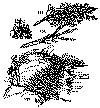By Dan Beard

Fig, 172. Slow-Water Dam
Fig. 173. Swift-Water Dam
Along the Atlantic and Pacific coasts Nature has furnished immense pools in which boys may swim to their hearts' content. At the edge of the Northern States the Great Lakes furnish ample opportunity for bathing, but there is a vast stretch of country between the Atlantic and the Pacific and south of the Great Lakes where there are thousands and thousands of boys but no oceans or lakes. It is for these boys that I am writing.
Of course, where the large rivers come near their homes, there is always good swimming from the sand-bars and flatboats, but only a small proportion of these boys live near the rivers. There are, however, but few of them who have not some little brook or creek in the neighborhood.
Suppose there is a brook in the pasture lot, a brook with a slow current too shallow for swimming, as in Fig. 172. You can see from this map that below a basin or marshy spot a point where the banks come close together has been selected as a proper place to build the dam. In this case the dam runs straight at right angles to the stream; but if the stream has a swift current, build the dam in the form of an arch with the convex side upstream and the concave side down, as shown in Fig. 173.

Figs. 174-176.
Fagots in Place.
To build this dam, cut a lot of brush like Fig. 174, trim it off like Fig. 175, then place it in the water with the pointed ends downstream and the branches upstream.
Commence in the middle of the stream to do this, and push the pointed ends into the bottom of the creek; then build each way until you reach the shore, as in Fig. 176.
When you trim the brush, save all the small branches and leaves in a pile together. After you have made the foundation like Fig. 176, weight it down with stones and clods. Cut some green logs and let them rest lengthwise against the bottom of the dam upon the upstream side. Begin again in the middle and lay more brush, working away toward each shore as you did in the first place; but this layer of brush is not trimmed--the small branches and leaves are left intact, as in Fig. 174. If you do this carefully your dam will now look like Fig. 177.

Fig. 177.
Brush over Fagots.
Of course, the water runs through this all the time, but as you build it up higher and higher, pressing each layer down with a weight of stones and mud and gravel, gradually less and less water will escape. When the dam has been made high enough to secure a sufficient depth of water in the pool, load down the dam with more logs and stones, hay, dry leaves, and such rubbish, until you have it as in Fig. 178.

Fig. 178.
Stones and Logs Over Brush
If you will look at Fig. 176 again you will see that any log you float in above the dam, and allow to rest lengthwise with the dam, will be held in place by the branching ends of the brush of which the dam is composed. After you have made your dam in the form of Fig. 178 plaster it over with clay and mud. In completing it, be sure there is plenty of mud and clay upon the inside or upstream part of the dam. This will stop the flow of water, and the latter will begin to rise in the artificial pool you have made by stopping up the outlet. Some water will seep through, but so long as it only trickles out of the bottom it will do no particular harm.

Fig. 179.
Clay, Mud, or Turf Over Logs and Stones.
Fig. 179 shows a finished dam. Build it according to the directions I have given and it should be a success, for this is the way the beavers build their dams.